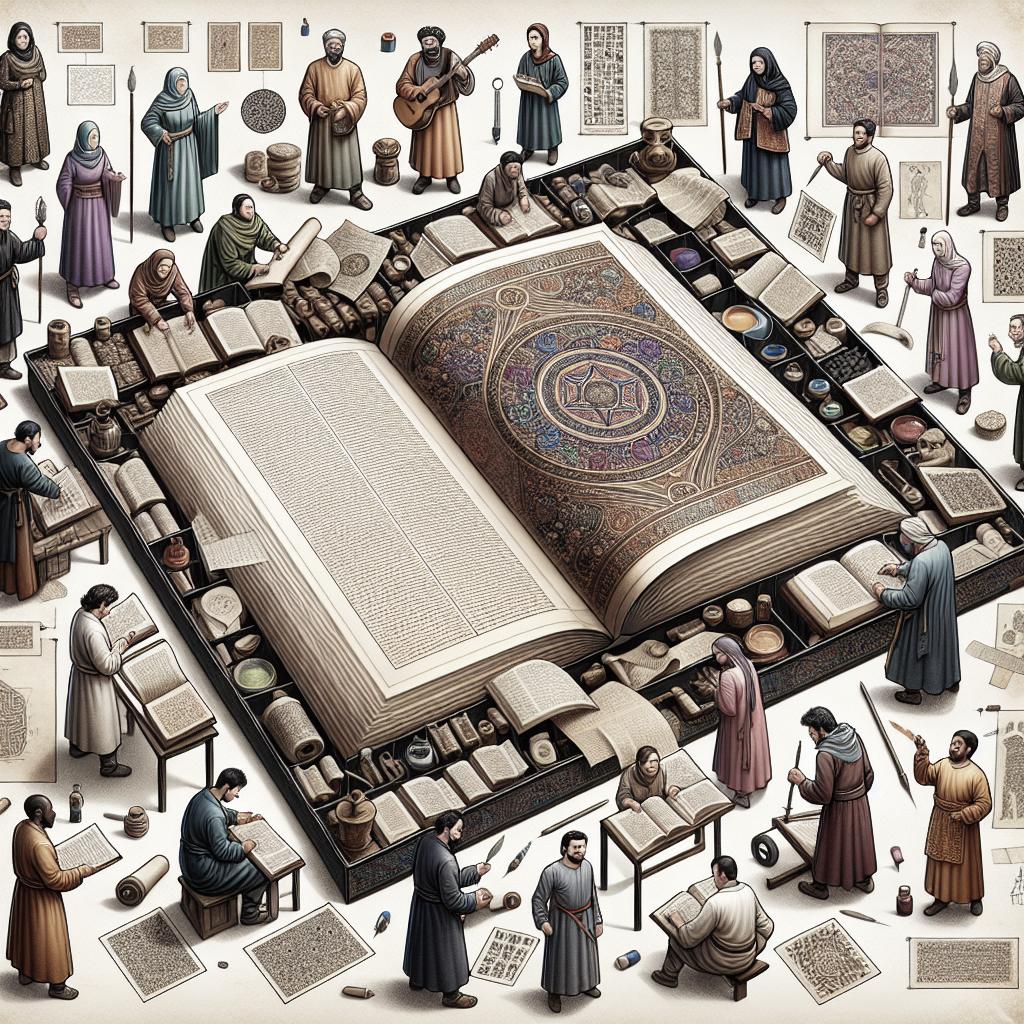<>
“`
Discovering the Makers of the Aztec Codex: A Historical Exploration
Codices have played a vital role in recording history, knowledge, and cultural heritage across civilizations. One of the most fascinating chapters in the history of codex creation is attributed to the Aztec civilization. They developed elaborate manuscripts that documented their rich history, religion, and daily life. This post undertakes a comprehensive exploration of the contributions of different cultures to codex creation and their impact on the preservation and dissemination of knowledge.
The Makers
The Aztecs employed trained scribes known as ‘tlacuilos’ who were responsible for creating the codexes. These scribes were skilled artists and historians, often hailing from the higher echelons of society. Their training began at a young age under the guidance of experienced elders. The tlacuilos meticulously translated oral traditions into visual and textual forms, ensuring the preservation of Aztec knowledge for future generations.
Moreover, the tlacuilos were not mere recorders of events but also interpreters of the symbols and icons that represented the complex, multifaceted Aztec worldview. These figures served both a historical and spiritual purpose, as the codices were often used in religious ceremonies and societal rituals, embodying the intricate connection between religion, governance, and daily life in Aztec culture.
The Process
The creation of a codex was a painstaking process. Aztec codices were typically made using bark paper, specifically from the amate tree, or deerskin, which was then smoothed and treated. The surface was polished with white lime, providing a suitable canvas for the vibrant pigments derived from natural minerals, plant extracts, and insects.
Once the materials were prepared, the tlacuilos began to inscribe the codex with intricate glyphs and pictographs. These manuscripts were often accordion-folded, facilitating the addition of new information over time. The binding and preservation methods utilized by the Aztecs ensured the longevity of these manuscripts, some of which have survived despite the ravages of time and conquest.
The Legacy
The Aztec codices provide an invaluable glimpse into the civilization’s unique traditions, social structures, religious beliefs, and interactions with the natural world. One of the most well-known codices is the Codex Borbonicus, which illustrates Aztec cosmology, calendrical systems, and sacred festivals. These manuscripts not only served as records but also as teaching tools, enabling the transmission of knowledge and customs across generations.
The tragic burning of many codices during the Spanish conquest underscores their importance as cultural artifacts. However, the surviving manuscripts offer a window into the pre-Columbian past, shedding light on a sophisticated system of knowledge that would otherwise be lost to history. The legacy of the Aztec codices underscores the enduring power of the written word in preserving cultural identity.
Conclusion
The contributions of the Aztecs to codex creation reflect a sophisticated understanding of art, history, and spirituality. Their careful documentation processes and the symbolic meaning embedded in their codices continue to captivate historians, anthropologists, and art enthusiasts alike. As we delve deeper into the history of codex creation across cultures, it becomes evident that these manuscripts are not merely documents but are profound testimonies of human cognition, creativity, and the desire to communicate across time.
The History of Codex: Invention and Evolution
The invention of the codex marked a pivotal moment in the history of written communication. Before the development of the codex format, texts were primarily written on scrolls made of papyrus or parchment, which were cumbersome and difficult to navigate. The transition to the codex format offered several practical advantages, including ease of use, durability, and the ability to integrate complex indices and tables of contents.
The codex first emerged in the Roman Empire around the first century AD and quickly gained popularity due to its practicality. Early codices were made from wooden tablets coated with wax, allowing for temporary notations. As the need for more permanent records grew, the use of parchment and vellum became common, offering a more durable and lasting medium for documentation.
Uncovering the Truth: Did Julius Caesar Invent the Codex?
The origin of the codex has intrigued scholars for decades, with various historical figures credited for its invention. One of the more debated theories is the suggestion that Julius Caesar may have played a pivotal role in the development of the codex. This theory posits that during his military campaigns, Caesar sought a more efficient way to manage his extensive notes and dispatches, leading to the early use of codices.
The New Theory
Recent scholarship has revisited the idea that Julius Caesar’s innovations in military logistics and administration may have extended to the creation of the codex. Some historians argue that Caesar, known for his organizational acumen, recognized the limitations of scrolls and pioneered the use of bound pages for strategic communication purposes. This hypothesis is supported by historical references to Caesar’s meticulous record-keeping and innovative use of technology in his campaigns.
However, direct evidence linking Caesar to the invention of the codex remains elusive. While the theory is intriguing, it is essential to consider it within the broader context of Roman technological advancements and the gradual evolution of written formats. The codex’s adoption likely resulted from a confluence of factors rather than the ingenuity of a single individual.
Why the Debate Matters
The debate over Julius Caesar’s role in inventing the codex highlights the complexities of attributing technological innovations to historical figures. Understanding the codex’s origins provides insight into the broader cultural and technological shifts that influenced its development. This debate also emphasizes the importance of interdisciplinary research, combining historical texts, archaeological findings, and paleographic studies to unravel the codex’s history.
The possibility that Caesar played a role in the codex’s early adoption sheds light on the intersections between military innovation, administrative efficiency, and literary culture in the Roman Empire. By examining these connections, historians can gain a deeper understanding of the factors that shaped the transition from scroll to codex, a transformation that had profound implications for the future of written communication.
The Bottom Line
Regardless of whether Julius Caesar himself invented the codex, it is clear that the Roman Empire significantly contributed to its development and popularization. The codex’s advantages over the scroll, including its portability, durability, and ease of reference, were recognized and embraced by Roman society. This early adoption set the stage for the codex’s widespread use in the medieval period, ultimately shaping modern book formats.
The ongoing scholarly debate underscores the importance of examining historical innovations within their cultural and contextual frameworks. By doing so, we can appreciate the complex interplay of factors that drive technological advancements and their lasting impact on human civilization.
The History of Codex: Invention and Evolution in Roman Civilization
The codex’s evolution in Roman civilization reflects a dynamic interplay of cultural, technological, and practical considerations. The transition from scroll to codex was not instantaneous but occurred over several centuries, influenced by changing literary practices and administrative needs. Roman scribes and scholars recognized the advantages of the codex format for both religious and secular texts, leading to its gradual adoption in various contexts.
In addition to its practicality, the codex’s structure facilitated the development of new literary and scholarly conventions. The ability to include marginalia, glosses, and complex indices allowed for more sophisticated interpretations and cross-referencing of texts. This innovation revolutionized the way information was organized and accessed, laying the groundwork for modern notions of textual analysis and academic scholarship.
Furthermore, the codex’s impact extended beyond the Roman Empire, influencing the development of Islamic and medieval European manuscript traditions. The codex’s versatility and durability made it an ideal medium for preserving religious, scientific, and literary works, ensuring the transmission of knowledge across different cultures and epochs.
Related posts:
- Discovering the Makers of the Aztec Codex: A Historical Exploration
- The History of Codex: Invention and Evolution
- Uncovering the Truth: Did Julius Caesar Invent the Codex?
Post navigation
Previous Post: The Evolution of Writing Systems: A Brief Overview
Next Post: The Impact of Digital Media on Traditional Publishing: A Comparative Study
Leave a Reply Cancel reply
Final Thoughts
| Section | Summary |
|---|---|
| Discovering the Makers of the Aztec Codex: A Historical Exploration | Examines the Aztec scribes (‘tlacuilos’), their processes, and the lasting legacy of their codices. |
| The History of Codex: Invention and Evolution | Traces the development of the codex from scrolls to its widespread use in Roman civilization. |
| Uncovering the Truth: Did Julius Caesar Invent the Codex? | Discusses new theories about Caesar’s involvement, the significance of the debate, and the ultimate impact of the codex in Roman civilization. |
“`


